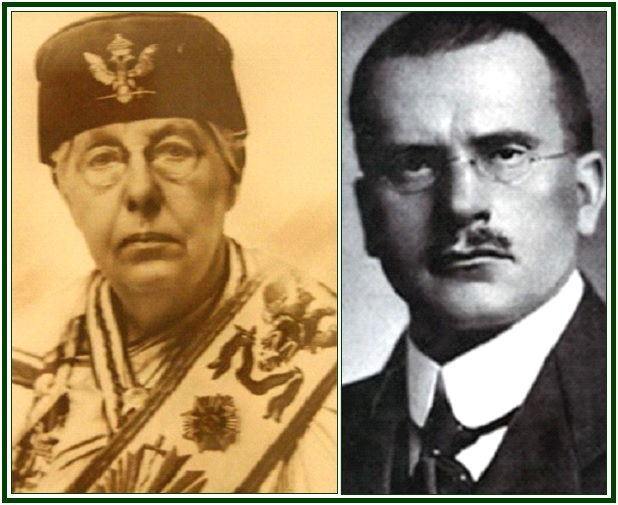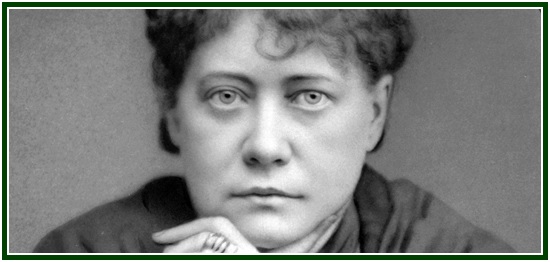
Two Sources of Trouble
for the Theosophical Movement
Carlos Cardoso Aveline

Annie Besant, in her masonic clothes, and Carl G. Jung, who in the
1930s worked with the Nazis precisely in the area of Psychologic ‘science’
Many a student of theosophy thinks Mrs. Annie Besant and her associates good-willingly caused a severe damage to the theosophical movement in the first half of the 20th century.
They led approximately 90 per cent of the movement to abandon the original teachings of theosophy given by Helena Blavatsky and the masters. They dedicated their best energies to create false “infallible” teachers, among them a clever imitation of Jesus Christ himself, humbly personified by Mr. J. Krishnamurti in public.
But any attitude that limits itself to blaming Ms. Besant and her false clairvoyants suffers from an incurable superficiality.
The central factor in the 20th century failures of the theosophical movement is rather silent. It is in the fact that the large majority of theosophists willingly accepted the top-down delusional programme created by Ms. Annie Besant and maintained by her successors.
Why is it that no numerically significant part of the movement strongly rejected Besantianism?
The key to the mystery is in that the right Pedagogy of the Masters had not been studied. There was no serious attempt to apply it after the 1890s. As a result, the illusions of the 1900-1934 Besant period – which are still alive today – constitute only a modest part of the real challenge to be faced in the 21st century.
There is a wide variety of mistakes in the non-Besantian groups, and in the “Blavatskian” sectors of the movement as well. Among them, we find the idea that memorizing and reciting the writings of Helena Blavatsky should be enough for the movement to attain its goals.
Here again, the problem is pedagogical.
The process of learning and teaching is a science in itself. The pedagogy of the Mahatmas needs to be studied in a proper way. The Mahatma Letters and the writings of Blavatsky transmit the right Epistemology and the main pedagogical tenets of esoteric philosophy, but they have been vastly ignored – with a few exceptions. [1]
The uncomfortable conclusion is that it is not correct to simply ascribe the responsibility for the failures of the movement to the Adyar leaders of the 1900-1934 period, or to any other leaders and organizations.
It is also unhelpful to blame the groups which do not share Adyar illusions, like the Pasadena Society and United Lodge of Theosophists.
True, they were unable to build a better and stronger movement than the Adyar Society, which could have led mankind, at least in part, to the spiritually flourishing 21st century mentioned in the last paragraphs of “The Key to Theosophy”, the book by Helena Blavatsky. But let us refrain from subjectively blaming anyone.
Now is the right occasion to act. Humanity is in time to win in the present century, whatever the price to pay in terms of karmic purification. While a stern look at the failures of the movement is of fundamental importance, any unilateral blame-game would work as a childish attempt to avoid our own responsibility. [2]
Besides, there are other mistakes to examine.
Carl Jung Updates Delusion
In the second part of last century, Carl G. Jung presented us a more sophisticated form of spiritual ignorance. Jung was remarkable for his work in deceiving himself and many others, which is a specialty of the Ningma School.
Jungianism succeeded in making even some “Blavatskian” students adopt the directly Ningmapasic ideas of the volume “The Tibetan Book of the Dead”, for instance.
Ethics is, of course, the science of sowing good Karma, and the adversaries of Ethics now have the joy of seeing many a theosophist adopt the Ningma-Jungian Psychology of ethical relativism, which has essential factors in common with the legacy of Annie Besant and her clairvoyants. (One of them being mental laziness.)
Carl Jung is considered a “necrophilous character” by Erich Fromm, his contemporary and one of the greatest Psychologists and Psychoanalysts of the 20th century.
During the 1930s, Jung was a collaborator of Nazism in Hitler’s Germany. He worked with Nazi Psychology. However, Jung followed the Ningma style: he presented himself as “spiritual” while despising both Ethics and religiosity.
Clever in using the disguising techniques of adopted by Nazis and Ningmas, Jungianism seems to fight the love of honesty in human heart. And this is an occult fight indeed. In the downward cycle of a degenerating civilization, such hedonistic tendencies are attractive to those who can’t love Truth in itself, and prefer worshipping appearance and comfort.
As in the case of Besant, the significant fact is not that Jung or Jungianism offered themselves to the theosophical movement as a charming path to moral failure. The key fact is that Jung and the Ningma illusion of “escaping the Law of Karma” got popular within the movement.
Ignoring the need for honesty and sincerity along the path became “acceptable”. Sincerity has been seen as “politically incorrect”, as unfriendly and “unbrotherly”, since it part of the probationary path. And the rejection of intellectual honesty as “unbrotherly” is also a pedagogical problem.
In the vertical downward phase of its decadence – also called “fall” or “implosion” – the West meets its own Karma.
However, what if the crisis is only Western and not global?
Or, in the terminology of “The Secret Doctrine”, the book by Helena Blavatsky, what if the present crisis belongs mainly to the fifth (Western) sub-race and civilization, and not to the fifth race (our humanity) as a whole?
In that case, a short term recovery is at hand for humanity. The healing may take place simultaneously and in parallel with the self-destructive implosion of the West.
If the crisis should belong to all of the present “fifth humanity”, the healing would also be simultaneous with the implosion; but it would be more difficult and complicated, and would take more time. The first half of the century may have significant lessons to teach us all.
Investigation must calmly go ahead as life unfolds.
NOTES:
[1] See the articles “Leaving the Masters Aside” and, for the almost invisible lineage of the original teachings, “The Prehistory of an Independent Lodge”.
[2] Once you indicate who is to blame, you tell yourself that you are blameless. Then you consider that the karma involved is not yours. You have no responsibility. As a result, you do not need to make any true effort. You can be in a comfortable, useless position. In a more realistic perspective, one must calmly look at the defeats of the movement in a rigorous way, in order to find alternatives and develop solutions. The purpose of recognizing mistakes done by others is to stop repeating them ourselves, and starting to act correctly.
000
The above article was published as an independent item in the associated websites on 5 October 2022. An initial version of it is part of the August 2022 edition of “The Aquarian Theosophist”, pp. 4-7, where it will be found under the title of “Besant and Jung in Esotericism”, and with no indication as to the name of the author.
000
Read more:
000

Helena Blavatsky (photo) wrote these revealing words: “Deserve, then desire”.
000